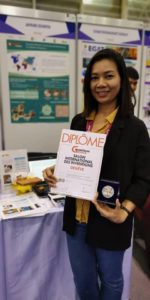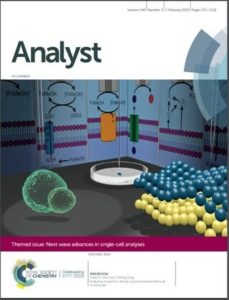We are delighted to introduce our latest Analyst Emerging Investigator, Deanpen Japrung!
 Deanpen Japrung received a BSc in Medical Technology from Chulalongkorn University and a MSc in Biochemistry from Mahidol University, Thailand. In 2010, she received a DPhil in Chemical Biology from the University of Oxford under supervision of Prof. Hagan Bayley. A post-doc in Prof. Joshua Edel and Prof. Tim Albrecht’s lab at Imperial College London followed this. In 2012, she became a researcher in Nano-Molecular Target Discovery laboratory, National Nanotechnology center (NANOTEC) and she was promoted to be a team leader of this lab in 2016. Since February 2019, she has also become a research group director of the Responsive Material and Nanosensor Research group. Her research has won awards from the Department of Medical Sciences (DMsc award in 2017), National Research Council of Thailand (NRCT research award in 2018), activity awards from the Diabetes Association of Thailand (in 2017, 2018 and 2019) and a silver medal from the 47th International Exhibition of Inventions, Switzerland (2019). So far, she has published 20 papers, more than 20 Thai Patents and 1 US patent (Granted). Her research group is focusing on synthesis and functionalization of responsive nanomaterial and development of nanosensors for disease diagnosis.
Deanpen Japrung received a BSc in Medical Technology from Chulalongkorn University and a MSc in Biochemistry from Mahidol University, Thailand. In 2010, she received a DPhil in Chemical Biology from the University of Oxford under supervision of Prof. Hagan Bayley. A post-doc in Prof. Joshua Edel and Prof. Tim Albrecht’s lab at Imperial College London followed this. In 2012, she became a researcher in Nano-Molecular Target Discovery laboratory, National Nanotechnology center (NANOTEC) and she was promoted to be a team leader of this lab in 2016. Since February 2019, she has also become a research group director of the Responsive Material and Nanosensor Research group. Her research has won awards from the Department of Medical Sciences (DMsc award in 2017), National Research Council of Thailand (NRCT research award in 2018), activity awards from the Diabetes Association of Thailand (in 2017, 2018 and 2019) and a silver medal from the 47th International Exhibition of Inventions, Switzerland (2019). So far, she has published 20 papers, more than 20 Thai Patents and 1 US patent (Granted). Her research group is focusing on synthesis and functionalization of responsive nanomaterial and development of nanosensors for disease diagnosis.
Read Deanpen’s Emerging Investigator Series paper “Ultrasensitive detection of lung cancer-associated miRNAs by multiple primer-mediated rolling circle amplification coupled with a graphene oxide fluorescence-based (MPRCA-GO) sensor” (free to access until the end of August 2019) and find out more about her in the interview below:
Your recent Emerging Investigator Series paper focuses on detection of lung cancer-associated MicroRNAs. How has your research evolved from your first article to this most recent article?
Our research group is focusing on development of nanosensor platforms for analysis of non-communicable diseases (NCDs), such as diabetes, Alzheimer and some cancers. Therefore, our first paper (as an independent researcher) was about the development of an aptasensor platform for the detection of glycated albumin, which is an intermediate biomarker for diabetes mellitus diagnosis (Biosens Bioelectron. 2016 Aug 15;82:140-5). In this paper, we used reduced graphene oxide to quench the fluorescence signal of the fluorescence labelled aptamer, which bind specifically to the glycated albumin. We measured fluorescence intensity when the fluorescence labelled aptamer left the graphene oxide to bind to the glycated albumin (target molecule). We found that the fluorescence intensity was dependent on the concentration of target molecules in the sample. Therefore, we calculated the glycated albumin concentration based on the standard curve from this system. After that we used computer simulation to study the binding mechanism of the DNA aptamer and reduced the graphene oxide (Molecular Simulation, 45:10, 841-848).
After these two publications, we have known how to deal with the graphene oxide quencher system, therefore we have continued develop the nanosensor platform using the reduce graphene oxide system to quench the fluorescence signal tag before binding to the other target molecules, such as DNA, RNA and other proteins. In the recent paper published in Analyst, apart from designing of new multiple primers, templates and using new ligase enzyme, we also used reduced graphene oxide to be a fluorescence quencher for detection of isothermal amplification product of target miRNA (miR-16, 21 and 210), which are biomarkers for lung cancer screening.
What aspect of your work are you most excited about at the moment?
The strategy employed in our study offers a significant improvement in sensitivity (1,000 folds compared to conventional multiple primers-mediated RCA method), specificity and detection time. This could prove very useful when detecting low abundant miRNAs e.g. miRNAs in serum/plasma and body fluids.
In your opinion, what are the key design considerations for developing sensors for MicroRNA detection?
I think the key design considerations for miRNA analysis is how to improve sensitivity, specificity and quantitative ability of the detection platform. More than 1000 types of microRNA (miRNA) have been discovered in the human body, however just small amount (<1 ng/mL) of miRNA is expressed and released into the blood circulation.
What do you find most challenging about your research?
The biggest challenges when conducting any research are finding real life applications for the research and how to commercialize the findings. To do all this, a research group consisting of multidisciplinary expertise is essential. An effective action plan is also vital.
How do you spend your spare time?
I love to spend time reading, book writing, painting with water colours and trail running. My favorite book is “Good luck” by Alex Rovira and Fernando Trias de Bes.
I am also a founder of the “Japrung Foundation for Rural Education” (2015-present). Our aim is to help poor students from the rural areas of Thailand. We do this by motivating them to believe in their own ability. The Foundation also offers scholarships.
Which profession would you choose if you were not a scientist?
If I were not a scientist, I would love to be a writer because I love writing. I have been invited to write science articles in Thai newspapers, such as the Thai Post.
Can you share one piece of career-related advice or wisdom with other early career scientists?
I have always followed four steps to make me a happy scientist. These steps are adapted and combined from my favorite book “Good luck” and the advice from a global career strategist, Laura Sheehan.
1) Be open and ready to change.
2) Gain more experience and adapt your skills.
3) Make meaningful connections.
4) Be a sharing person.















